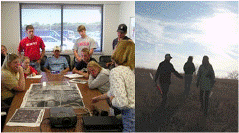Environmental and Sustainability Studies Program

Department of Environmental Studies: Undergraduate Student Theses
Date of this Version
Spring 2015
Document Type
Thesis
Citation
Environmental Studies Undergraduate Student Thesis, University of Nebraska–Lincoln, 2015
Abstract
Determining how temperature alters direct predation and indirect trophic cascade effects will be crucial in understanding how global climate change affects community structure and stability. While we are starting to comprehend the effects of warming on individual trophic interactions and underlying mechanisms, effects of warming on multilevel food webs are mostly unknown. This study sought to experimentally observe potential effects of temperature on population and community dynamics, and the magnitude of trophic cascades. To reach these objectives, a three-tiered food web (Scenedesmus, Daphnia and Hydra) was designed, maintained, and observed at two different temperatures (17°C and 21°C) for 37 days. Results found that Daphnia population dynamics shifted, with the 21°C treatments demonstrating higher density peaks, faster population declines, and an additional population cycle over the duration of the study. Scenedesmus populations showed no response to differential Daphnia population dynamics. While a strong trophic cascade effect was found, no differences were observed between temperatures. The experimental design may have been overly limited to accurately observe trophic cascade effects, so more research is encouraged. Mechanisms for Daphnia population dynamic shifts were hypothesized, including temperature-dependent rates of maturation and mortality, reproductive timing and capacity, and Scenedesmus productivity. Consequences of temperature-induced population dynamic shifts were explored, concluding that similar effects in vivo may contribute to uncoupling of predator-prey interactions, and increased community instability.


Comments
Copyright © 2015 Reed Brodersen